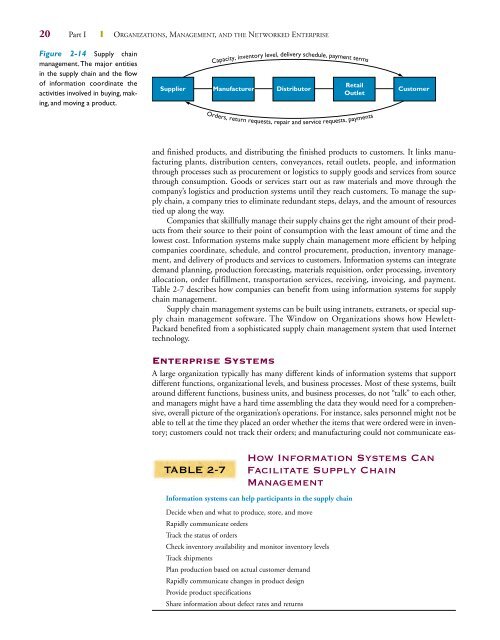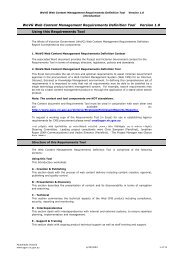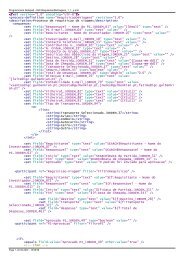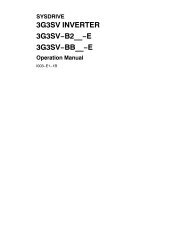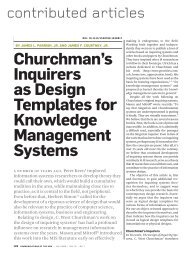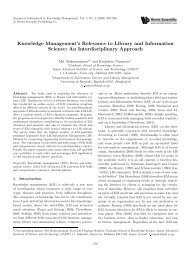2 Information Systems in the Enterprise - Main Web
2 Information Systems in the Enterprise - Main Web
2 Information Systems in the Enterprise - Main Web
Create successful ePaper yourself
Turn your PDF publications into a flip-book with our unique Google optimized e-Paper software.
20 Part I ❙ ORGANIZATIONS, MANAGEMENT, AND THE NETWORKED ENTERPRISE<br />
Figure 2-14 Supply cha<strong>in</strong><br />
management. The major entities<br />
<strong>in</strong> <strong>the</strong> supply cha<strong>in</strong> and <strong>the</strong> flow<br />
of <strong>in</strong>formation coord<strong>in</strong>ate <strong>the</strong><br />
activities <strong>in</strong>volved <strong>in</strong> buy<strong>in</strong>g, mak<strong>in</strong>g,<br />
and mov<strong>in</strong>g a product.<br />
and f<strong>in</strong>ished products, and distribut<strong>in</strong>g <strong>the</strong> f<strong>in</strong>ished products to customers. It l<strong>in</strong>ks manufactur<strong>in</strong>g<br />
plants, distribution centers, conveyances, retail outlets, people, and <strong>in</strong>formation<br />
through processes such as procurement or logistics to supply goods and services from source<br />
through consumption. Goods or services start out as raw materials and move through <strong>the</strong><br />
company’s logistics and production systems until <strong>the</strong>y reach customers. To manage <strong>the</strong> supply<br />
cha<strong>in</strong>, a company tries to elim<strong>in</strong>ate redundant steps, delays, and <strong>the</strong> amount of resources<br />
tied up along <strong>the</strong> way.<br />
Companies that skillfully manage <strong>the</strong>ir supply cha<strong>in</strong>s get <strong>the</strong> right amount of <strong>the</strong>ir products<br />
from <strong>the</strong>ir source to <strong>the</strong>ir po<strong>in</strong>t of consumption with <strong>the</strong> least amount of time and <strong>the</strong><br />
lowest cost. <strong>Information</strong> systems make supply cha<strong>in</strong> management more efficient by help<strong>in</strong>g<br />
companies coord<strong>in</strong>ate, schedule, and control procurement, production, <strong>in</strong>ventory management,<br />
and delivery of products and services to customers. <strong>Information</strong> systems can <strong>in</strong>tegrate<br />
demand plann<strong>in</strong>g, production forecast<strong>in</strong>g, materials requisition, order process<strong>in</strong>g, <strong>in</strong>ventory<br />
allocation, order fulfillment, transportation services, receiv<strong>in</strong>g, <strong>in</strong>voic<strong>in</strong>g, and payment.<br />
Table 2-7 describes how companies can benefit from us<strong>in</strong>g <strong>in</strong>formation systems for supply<br />
cha<strong>in</strong> management.<br />
Supply cha<strong>in</strong> management systems can be built us<strong>in</strong>g <strong>in</strong>tranets, extranets, or special supply<br />
cha<strong>in</strong> management software. The W<strong>in</strong>dow on Organizations shows how Hewlett-<br />
Packard benefited from a sophisticated supply cha<strong>in</strong> management system that used Internet<br />
technology.<br />
<strong>Enterprise</strong> <strong>Systems</strong><br />
A large organization typically has many different k<strong>in</strong>ds of <strong>in</strong>formation systems that support<br />
different functions, organizational levels, and bus<strong>in</strong>ess processes. Most of <strong>the</strong>se systems, built<br />
around different functions, bus<strong>in</strong>ess units, and bus<strong>in</strong>ess processes, do not “talk” to each o<strong>the</strong>r,<br />
and managers might have a hard time assembl<strong>in</strong>g <strong>the</strong> data <strong>the</strong>y would need for a comprehensive,<br />
overall picture of <strong>the</strong> organization’s operations. For <strong>in</strong>stance, sales personnel might not be<br />
able to tell at <strong>the</strong> time <strong>the</strong>y placed an order whe<strong>the</strong>r <strong>the</strong> items that were ordered were <strong>in</strong> <strong>in</strong>ventory;<br />
customers could not track <strong>the</strong>ir orders; and manufactur<strong>in</strong>g could not communicate eas-<br />
TABLE 2-7<br />
Capacity, <strong>in</strong>ventory level, delivery schedule, payment terms<br />
Retail<br />
Supplier Manufacturer Distributor<br />
Customer<br />
Outlet<br />
Orders, return requests, repair and service requests, payments<br />
How <strong>Information</strong> <strong>Systems</strong> Can<br />
Facilitate Supply Cha<strong>in</strong><br />
Management<br />
<strong>Information</strong> systems can help participants <strong>in</strong> <strong>the</strong> supply cha<strong>in</strong><br />
Decide when and what to produce, store, and move<br />
Rapidly communicate orders<br />
Track <strong>the</strong> status of orders<br />
Check <strong>in</strong>ventory availability and monitor <strong>in</strong>ventory levels<br />
Track shipments<br />
Plan production based on actual customer demand<br />
Rapidly communicate changes <strong>in</strong> product design<br />
Provide product specifications<br />
Share <strong>in</strong>formation about defect rates and returns


